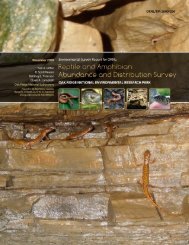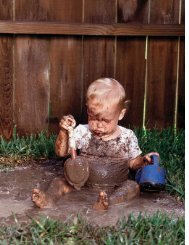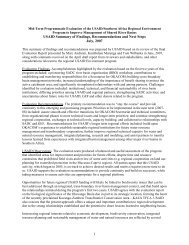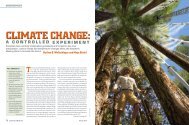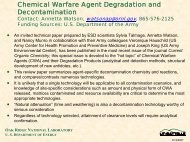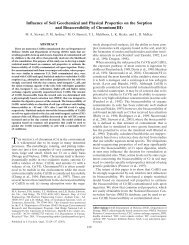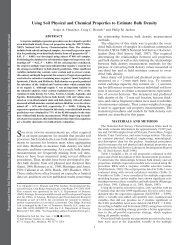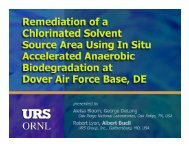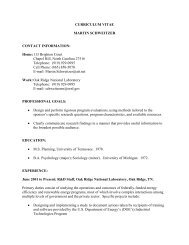the herpetofauna of the oak ridge area - Oak Ridge National ...
the herpetofauna of the oak ridge area - Oak Ridge National ...
the herpetofauna of the oak ridge area - Oak Ridge National ...
- No tags were found...
Create successful ePaper yourself
Turn your PDF publications into a flip-book with our unique Google optimized e-Paper software.
ORNL-3653: - -UC-48 - Biology and MediiineT1D-.t5S)O (34th ed.)--. -OAK RIDGE NATIONAL LABQRATBR'r"_.-rUNION CARBIDE CORPORATtONfor <strong>the</strong>3.S. 'ATOMIC ENERGY COMMISSION
JORNL-3653Con t ro ct N 0, W -7405 -en g -26HEALTH PHYSICS DlWllSlONTHEHERPETOFAUNAOFTHEOAK RIDGE AREAR. M. Johnson**Present address: Department <strong>of</strong> Biology, Asheville-Bi ltmore College, Asheville,North Carolina. Work perforrned under Subcontract No. 2284 with Tennessee Poly-technic Institute.DECEMBER 1964OAK RIDGE NATIONAL LABORATORY<strong>Oak</strong> <strong>Ridge</strong>, Tennesseeoperated byUNION CARBIDE CORPORATIONfor <strong>the</strong>U. S. ATOMIC ENERGY COMMISSION3 4456 0059774 I.I
ACKNOWLEDGMENTSThis report describes research conducted under <strong>the</strong> direction <strong>of</strong> S. I. Auerbach, Chief, RadiationEcology Section, Health Physics Division, <strong>Oak</strong> <strong>Ridge</strong> <strong>National</strong> Laboratory. Financial support wasreceived from <strong>Oak</strong> <strong>Ridge</strong> <strong>National</strong> Laboratory and Tennessee Polytechnic Institute under SubcontractNo. 2284.Appreciation is expressed to S. I. Auerbach, Paus B. Dunaway, R. C. Early, Fred Taylor, J. A.Payne, B. E. Jacobs, and T. P. O’Farrell, all <strong>of</strong> <strong>the</strong> Radiation Ecology Section, for <strong>the</strong>ir manycourtesies, helpful suggestions, and assistance in obtaining specimens, Ronald Quarles andJoseph F. Webb, senior biology students at Tennessee Polytechnic Institute, gave invaluable assistancein <strong>the</strong> field and laboratory. John R. Warren, Chairman <strong>of</strong> <strong>the</strong> Department <strong>of</strong> Biology, and<strong>the</strong> Administration <strong>of</strong> Tennessee Polytechnic Institute receive my thanks for enabling me to engagein this research.,....111
CONTENTSACKNOWLEDGMENTS ......................................................................................................................... iiiABSTRACT ............................................................................................................................................. 1I . INTRODUCTION ....................................................... .................................................................. 1I1 . MATERIALS AND METHODS ........................................................................................................A . The Study Area ........................................................................................................................B . Methods <strong>of</strong> Collecting ..........................................................................................................................................................................................................................................C Habitat TypesD . Identification and Presentation <strong>of</strong> Species .......................................................................E . Reference Collection ...........................................................................................................111 . THE HERPETOFAUNA ..............................................................................................................A . Taxonomy and Nomenclature ................................................................................................B . Class Amphibia: Order Caudata ............................................................................................1 Family Ambystomstidce ..............;.....................................................................................2 Family Salamanclridae .............................................................. ;.........................................3 . Family Plethodontidne ........................ ;...........................................................................C . .Class Amphibia: Order Anurn ...............................................................................................1 . Family Pelobaticlae ............................................................................................................2 Family Bufonidae ..........................................................................................................3 Family Hylidae ..................................................................................................................' 4 Family Microhylidae ................................. "........................................................................5 . Family Ranidoire ..................................................................................................................D . Class Reptilia: Order Testudinatu ....................................................................................1 Family Chelydridne ............................................................................................................2 Family Tcstudinidae ......................................................................................................3 . Family Trionychidae ..........................................................................................................E . Class Reptilio: Order Squamata: Suborder Lncertilia ......................................................1 Family Iguanidae .................................................................................................................2 . Family Teiidae .................... ........................................................................................3 . Family Scincidat? ..............................................................................................................F . Class Reptilin: Order Squumata: Suborder Serpentes ......................................................1 . Family Colr~bridae ..............................................................................................................2 Family Viperidae .................................................................................................................IV . DISCUSSION AND CONCLUSIONS ............................................................................................ 22A . The Herpct<strong>of</strong>auna .................................................................................................................. 223 . Relative Abundance ................................................................................................................. 22C . Populations Suitable for Field Investigations .................................................................... 25V . LITERATURE CITED .................................................................................................................... 26
THEHERPETOFAUNAOFTHEQAKRIDGEAREAR. M. JohnsonA BST R ACTThe hetpet<strong>of</strong>auna <strong>of</strong> <strong>the</strong> <strong>Oak</strong> <strong>Ridge</strong> <strong>area</strong> was investigated (a) to ascertain <strong>the</strong>kinds <strong>of</strong> amphibians and reptiles (herptiles) occutring in <strong>the</strong> <strong>area</strong>, (b) to evaluatehabitat preferences <strong>of</strong> <strong>the</strong> herptiles, (c) to evaluate <strong>the</strong> suitability <strong>of</strong> <strong>the</strong> variousspecies populations for ecological investigations, and (d) to prepare a referencecollection <strong>of</strong> herptiles <strong>of</strong> <strong>the</strong> <strong>area</strong>.Collecting was performed by (a) prowling about <strong>the</strong> various kinds <strong>of</strong> habitatsby day and by night and collecting by hand, (b) walking transects by day and bynight and collecting by hand, (c) trapping with hardware-cloth drift fences andfunnel traps in terrestrial habitats, (d) using dipnet, funnel traps, and hoop netsin aquatic habitats, and (e) driving roads by day and by night. The most productivemethod <strong>of</strong> collecting in terrestrial habitats and streams was hand collecting; influvial and pond habitats it was with dipnet, funnel trap, and hoop net.The numbers <strong>of</strong> monotypic species <strong>of</strong> herptiles collected are as follows: salamanders,3; anurans, 2; turtles, 2; lizards, 4; and snakes, 2. The numbers <strong>of</strong> polytypicspecies collected are as follows (numbers in paren<strong>the</strong>ses are subspecies represented):salamanders, 4 (4); anurans, 10 (12); turtles, 8 (10); lizards, 1 (1);and snakes, 15 (18). The largest numbers <strong>of</strong> species and specimens were collectedin flood-plain and pond habitats; <strong>the</strong> least numbers were collected in pine plantations.Herptiles judged as occurring in populations <strong>of</strong> sufficient size, seasonalavailability, and ease <strong>of</strong> sampling for extensive field and laboratory investigationsare as follows: Desmogtiathus fuscus; Nyla versicolor; Acris crepitans; Ranaclamitnns; R. palustris; Chryaemys picfa; Pseudemys scripta; lliatrix septcmviltata;and N. sipedon.A reference collection containing specimens <strong>of</strong> each Species and subspeciescollected was prepared and deposited with <strong>the</strong> Radiation Ecology Section, HealthPhysics Division.1. INTRODUCTIONTwo surveys have been made <strong>of</strong> <strong>the</strong> <strong>herpet<strong>of</strong>auna</strong> <strong>of</strong> eastern Tennessee (Johnson, 1958; King,1939). The <strong>Oak</strong> <strong>Ridge</strong> <strong>area</strong> was omitted from both <strong>of</strong> <strong>the</strong>se studies. Thus, <strong>the</strong> <strong>herpet<strong>of</strong>auna</strong> <strong>of</strong> <strong>the</strong><strong>Oak</strong> <strong>Ridge</strong> <strong>area</strong> could only be inferred. Recognizing <strong>the</strong> desirability <strong>of</strong> a knowledge <strong>of</strong> <strong>the</strong> <strong>herpet<strong>of</strong>auna</strong><strong>of</strong> <strong>the</strong> <strong>Oak</strong> <strong>Ridge</strong> Area, S. I. Auerbach, Chief, and Paul B. Dunaway, Mammalogist, RadiationEcology Section, suggested <strong>the</strong> survey herein reported.The objectives <strong>of</strong> this survey were to (a) ascertain <strong>the</strong> species and subspecies <strong>of</strong> amphibiansancl reptiles (herptiles) occurring in <strong>the</strong> <strong>Oak</strong> <strong>Ridge</strong> <strong>area</strong>, (b) evaluale habitat preferences <strong>of</strong> <strong>the</strong>herptiles, (c) evaluate <strong>the</strong> suitability <strong>of</strong> <strong>the</strong> various species populations for ecological investigatiolis,and (d) prepare a reference collection <strong>of</strong> herptiles.1
2II. MATERIAL-S AHD METHODSA. The Study AreaThe entire <strong>Oak</strong> <strong>Ridge</strong> <strong>area</strong> (sec Map S-16A, 1959, <strong>Oak</strong> <strong>Ridge</strong> Area) was included in <strong>the</strong> survey.Collection sites were selected on <strong>the</strong> bases <strong>of</strong> suggestions <strong>of</strong> P. E. Dunaway, R. C. Early, F.Taylor, o<strong>the</strong>r personnel <strong>of</strong> <strong>the</strong> Radiation Ecology Section, and <strong>of</strong> past experience with <strong>the</strong> collecting<strong>of</strong> herptiles in eastern Tennessee.Collections were made in each <strong>of</strong> <strong>the</strong> mnjor recognized types <strong>of</strong> habitats and many <strong>of</strong> <strong>the</strong> establishedEcology Study <strong>area</strong>s, No effort was made to spend equal numbers <strong>of</strong> trap-hours or iilan-hoursin each kind <strong>of</strong> habitat, but <strong>the</strong> number <strong>of</strong> hours spent in each was recorded, as were <strong>the</strong> speciesand numbers <strong>of</strong> individuals collected. 'The habitat bordering <strong>the</strong> road was recorded when specimenswere encountered on <strong>the</strong> roads.B. Methods <strong>of</strong> CollectingThe kinds <strong>of</strong> equipment used in <strong>the</strong> performance <strong>of</strong> <strong>the</strong> field work were as follows: garden cultivator,wrecking bar, dipnet, cloth sacks and glass jars, polystyrene coolers, 6-v battery-poweredheadlamp, and funnel traps.The fuiitirl trap was a rectangle with an entrance in one end. The entrance was a recliningpyramid extending 10 to 15 in. into <strong>the</strong> trap. At <strong>the</strong> apex <strong>of</strong> <strong>the</strong> pyramid was a 2- by 5-in. openingpositioned approximately 5 in. above <strong>the</strong> bottom <strong>of</strong> <strong>the</strong> cage. The pyramidal entrance to <strong>the</strong> trapwas fitted with a partition <strong>of</strong> hardware cloth, which resulted in two adjacent openings each approximately2 by 2.5 in. at <strong>the</strong> apex. 'l'he partition extended several inches beyond <strong>the</strong> opening into <strong>the</strong>trap and was laced to a drift fence. The trap was 15 in. in cross section and 30 in. long. It wasconstructed <strong>of</strong> mesh hardware cloth.The drift fence was a strip <strong>of</strong> '6-in. mesh hardware cloth 30 in. high and 50 ft long. A funneltrap was secured to each end <strong>of</strong> <strong>the</strong> fence. The fence was buried in <strong>the</strong> giound for a depth <strong>of</strong>about 2 in. and secured to stakes at intervals sufficiently close to keep <strong>the</strong> fence upright. Oneexception to this arrangement was an installation <strong>of</strong> one trap, froni each front corner <strong>of</strong> which afence 254 long extended at a 45O angle.Animals collected by <strong>the</strong>se drift-fence installations were removed from <strong>the</strong> ttaps through a hole(covered while <strong>the</strong> trap was in operation) in <strong>the</strong> top <strong>of</strong> <strong>the</strong> trap.A larger funnel trap constructed on <strong>the</strong> same plan as described above, but <strong>of</strong> %-in. mesh hardwarecloth, was used to collect turtles in <strong>the</strong> pond in Section D-4. Drift fences were not used withthis trap. It was merely placed in <strong>the</strong> water. The back corner <strong>of</strong> <strong>the</strong> trap was raised above <strong>the</strong>surface <strong>of</strong> <strong>the</strong> water to pcumit trapped turtles to obtain air.At old house places, cover sets wcre arranged. These consisi.ed <strong>of</strong> lumber, tin, and o<strong>the</strong>r rubbleplaced in piles <strong>of</strong> a size convenient to handle. 'These cover sets wer? visited at irregular intervalsand moved to collect herptiles, which may have been utilizing <strong>the</strong>m for cover while resting, forparturition or egg-laying, or hunting food.
3A total <strong>of</strong> eight drift-fence installations were used. The sites at which <strong>the</strong>se were installedwere Ecology Study <strong>area</strong>s 0800 (oId field), 0801 (pine plantation and mixed hardwood and pine),0804 (house place), 7850 (upland forest and flood-plain forest), and 7851 (ruderous habitat). Ano<strong>the</strong>rinstallation was in an old field-transition in Sector F-7 approximately 1 mile west <strong>of</strong> <strong>the</strong>West Portal <strong>of</strong> ORNL.Cover sets and drift-fence installations were supplemented with hand collecting. This wasconducted in two ways, One method consisted <strong>of</strong> merely exploring <strong>the</strong> <strong>Oak</strong> <strong>Ridge</strong> <strong>area</strong> and collectingwhere persons recommended and where experience and intuition suggested herptiles might befound. The o<strong>the</strong>r method consisted <strong>of</strong> establishing transects and periodically traversing <strong>the</strong>m.Transects were established in Ecology Study <strong>area</strong>s 0800 (old field), 0916 (upland forest), and 7660(old field, old field-transition, and upland forest). These line transects were 500 ft long, 1063 ftlong, and 1100 ft long, respectively. They were laid out on compass bearings and marked withcane poles and trees, which were sprayed with chrome-aluminum paint. Hand collecting was doneat night as well as during <strong>the</strong> day. Specimens encountered on <strong>the</strong> roads during travel around <strong>the</strong><strong>area</strong> were also collected.C. Habitat Types1. Fluvial Hubitut. The Clinch River, Poplar Creek, and East Fork Poplar Creek to about <strong>the</strong>800-ft contour line are included in this category. Characteristics <strong>of</strong> this habitat are [a) generallystetp banks <strong>of</strong> bare soil or rock cliffs and ledges where exposed, (b) moderate LO deep channel, (c)continuous current, although variable in rate <strong>of</strong> flow in even a 24-hr period, and (d) usually turbidwater.2. Stream Habitat. This includes such water courses as Bear Creek, East Fork <strong>of</strong> PoplarCreek above <strong>the</strong> 800-fi contour line, and Grassy Creek. Characteristics <strong>of</strong> this habitat ate (a) silt,sand, and gravel bottom in level portions and gravel-and-rock bottom where <strong>the</strong> fall is more precipitous,(b) depth varying from a few inches to several feet, frequent scour holes, (c) gravel andsand-and-mud bars occurring in level portions, (d) continuous current, affected primarily by precipitationor lack <strong>of</strong> it, (e) shoreline steep or low, in <strong>the</strong> latter case with a sparse to dense cover <strong>of</strong>emergent herbaceous or woody vegetation or both, and (f) width varying from 4 It to as broad as20 ft.3. Spring Branch. This habitat is characterized by (a) clear water derived from one or moresprings, (b) relatively constant temperature, (c) bottom varying from silt to gravel and rock, dependingupon substrate and slope, (d) current continuous, except during dry periods, (e) waterdepth usually shallow, seldom exceeding 1 ft, (f) freedom from aquatic vegetation in heavilywooded, well-drained, or precipitous <strong>area</strong>s, or dense attached, emergent and submergent vegetationin low, poorly drained <strong>area</strong>s.4, Springs. This refers to <strong>the</strong> “boil” <strong>area</strong> where ground water issues from <strong>the</strong> substrate.
5. Rmbayrnent. This refers to <strong>the</strong> impoundments lateral to <strong>the</strong> Clinch Kiver. These are charac-terized by (a) turbid water (sometimes more so than <strong>the</strong> river), (b) periodic rise and fall <strong>of</strong> waterlevel, <strong>of</strong>ten several feet in a single 24-hr period, (c) usually gently sloping shoreline covered withherbaceous or herbaceous and woody vegetation, which may be emergent or submerged dependingupon water level, (d) reversible curient affected by rise and fall <strong>of</strong> <strong>the</strong> river level or none, and (e)possibility <strong>of</strong> becoming fluvial habitats in time <strong>of</strong> low water if <strong>the</strong>y are drowned stream or riverniou th s .6. Pond. A permanent body <strong>of</strong> water except during prolonged dry periods. It is characterizedby (a) zonal stratification <strong>of</strong> shoreline vegetation, (b) abundant algal growth, both floating and at-tached, (c) shoreline <strong>of</strong> grasses, sedges, and ivshes or this herbaceous Vegetation plus woodyplants, (d) no current, and (e) high temperatures (over 3OOC) in late spring and summer.7. Pool. A temporary body <strong>of</strong> water, seldom lasting for more than a few weeks after beingformed by rainfall or flooding from an adjacent river or stream. The bottom and <strong>the</strong> kinds <strong>of</strong> vegeta-tion occurririg in it depend upon <strong>the</strong> site. Roadside ditches are <strong>the</strong> smallest type <strong>of</strong> pool; flood-plain pools residting from overflow <strong>of</strong> <strong>the</strong> river are among <strong>the</strong> largest.arsh. A continually wet <strong>area</strong> characterized by (a) saturated organic substrate, (b) densevegetation <strong>of</strong> sedges, grasses, and rushes, (c) supply <strong>of</strong> ground water as well as rainfall, and (d) asurface temperature <strong>of</strong> <strong>the</strong> water that may exceed 3OoC in late summer. Button bush and willowmay encircle it and occur in it.9. Spring Seep. This is a marsh in miniature, if it occurs in an arsa that is relatively low andpoorly drained and exposed to <strong>the</strong> sky. In wooded arcas living vegetation is <strong>of</strong>ten replaced by athick deposit <strong>of</strong> leaves and branches. The organic or organic and mud-and-silt bottom is saiurated.Except in dry wea<strong>the</strong>r <strong>the</strong>re is usually a detectable current. The water temperature remains rela-tively constant even in <strong>the</strong> summer.10. Upland Forest. Deciduous forest occurring on well-drained sites. It has at least threestrata - canopy, understory or shrub layer, and ground cover. Canopy trees include <strong>oak</strong>s, hicko-ries, niaples, tulip poplar, and beech in varying combinations depending upon slope exposure.Understory and shrub layers contain dogwood, <strong>oak</strong>s, hickories, maple, and beech. The groundcover consists <strong>of</strong> seedlings <strong>of</strong> canopy or understory species, ferns, and vernal herbaceous plants.Leaf litter is usually well developed.11. Flood-Plain Forest. Deciduous forest occurring in stream valleys and poorly drained sites.It has at least three strata ... canopy, understory or shrub layer, and ground cover. Canopy speciesinclude sweet gum, sycamore, <strong>oak</strong>s, and not infrequently pine. The understory and shrub layer con-tain saplings and pole-sized trees <strong>of</strong> <strong>the</strong> canopy species, ironwood, hop hornbeam, and maples. Theground cover is <strong>of</strong>ten dense acontains grasses, vines, and cane.12. Mixed Hardwood and ne, As implied by <strong>the</strong> name, this habitat is characterized by de-ciduous trees <strong>of</strong> various species, depending upon site, and pine in nearly equal abundance. In up-land sites <strong>the</strong> deciduous species include those listed for upland forest; in lowland sites, <strong>the</strong> de-ciduous species include those listed for <strong>the</strong> flood-plain forest. Understory OK shrub layers or both
5may be present. Characteristically, <strong>the</strong> ground cover is composed <strong>of</strong> grasses and perennial weeds.Floristic composition varies with <strong>the</strong> site. The leaf-litter layer when developed consists <strong>of</strong> leaves<strong>of</strong> both hardwood species and pine.113. Pine Plantation. This refers to woods composed <strong>of</strong> planted pines. The trees are in rows,<strong>the</strong> canopy is closed, <strong>the</strong> substrate consists almost entirely <strong>of</strong> a thick mat <strong>of</strong> pine needles, and<strong>the</strong>re is no understory, shrub layer, or ground-cover vegetation. As regards herptiles, <strong>the</strong>se habitatsare sterile.14. Old Field-Transition. This refers to abandoned fields in advanced stages <strong>of</strong> successionto forest. Saplings and pole-sized deciduous and pine trees are numerous. Grasses and perennialweeds are <strong>the</strong> dominant ground cover, although bramble patches and vines such as honeysuckle maybe “locally 3bundant.”115. Old Field. This refers to abandoned fields in which grasses and perennial wceds are <strong>the</strong>dominant vegetation. Brambles may be present as scattered individual plants or isolated clones.Saplings <strong>of</strong> pine, cedar, and sumac may be present as widely spaced individual plants.16. Ruderous Area. This refers to sites where nature or human activity have removed most orall <strong>of</strong> <strong>the</strong> vegetation. Areas <strong>of</strong> bare substrate are present. Rubble may be scattered about. Whatvegetation does occur consists <strong>of</strong> bunch grasses, annual weeds, some perennial weeds, and patches<strong>of</strong> lichens and drought-resistant mosses. Occasional cedars, pines, or <strong>oak</strong> seedlings and saplingsmay be present.17. House Place. This refers to abandoned homesites. Honeysuckle and brambles are a cornmonfeature <strong>of</strong> this habitat. The ground cover elsewhere is most <strong>of</strong>ten a dense sod <strong>of</strong> grass orgrass and perennial weeds. Collapsing buildings and o<strong>the</strong>r rubble may be present.Admittedly, <strong>the</strong>se habitats are ra<strong>the</strong>r subjectively defined. However, <strong>the</strong>y are accurate enoughto cliaracterize <strong>the</strong> kinds <strong>of</strong> situations in which <strong>the</strong> various herptiles have been collected.I).identification and Presentation <strong>of</strong> SpeciesIdentifications <strong>of</strong> specimens were based upon comparisons with material in <strong>the</strong> research col-lections <strong>of</strong> <strong>the</strong> Department <strong>of</strong> Biology, Tennessee Polytechnic Institute, and with literature reportsas follows: salamanders - Bishop (1941-1947), Highton (1962), and Valentine (1963); anurans -Walker (1946), and Wright and Wright (1949); turtles - Cagle (1953), Carr (1952), Tinkle (1958),Tinklk and Webb (1955), and Webb (1962); lizards - Smith (1942); snakes - Auffenberg (1955),Blanchard (1921, 1942), Conant (1946), Clay (1938), Dowling (1951a), Neil1 (1963), and Wright andWright (1959). General references used were Blair ef al. (1957) and Conant (1958).In <strong>the</strong> presentation <strong>of</strong> <strong>the</strong> <strong>herpet<strong>of</strong>auna</strong>, <strong>the</strong> section on identification contains <strong>the</strong> informationupon which <strong>the</strong> identification was decided; it is not intended as complete description <strong>of</strong> eachspecies or subspecies.
6Standard measurements, counts <strong>of</strong> morphological attributes, and color descriptions were employed.The number <strong>of</strong> ventral scutes for snakes was counted by <strong>the</strong> traditional method and by <strong>the</strong>method recommended by Dowlitig (1951b). The latter counts have been recorded in paren<strong>the</strong>ses(accounts <strong>of</strong> snakes).Localities listed for each species infer to sectors on Map S-16A. The localities include <strong>area</strong>swhere sightings <strong>of</strong> individuals, calls, shed skins, and o<strong>the</strong>r identifiable evidence <strong>of</strong> th- occurtence<strong>of</strong> a herptile were observed. Localities were also listed on <strong>the</strong> basis <strong>of</strong> creditable repoits by personnel<strong>of</strong> <strong>the</strong> Radiation Ecology Section.The habitats for each species are listed in order <strong>of</strong> frequency <strong>of</strong> occurlence as indicated by <strong>the</strong>results <strong>of</strong> this survey and prior experience. If two or more habitats seem to be frcquented wi<strong>the</strong>qual regularity, <strong>the</strong>y are presented with <strong>the</strong> conjunction “and.”eference CollectionEach species reported upon in this paper is represented by one or more preserved specimens.The specimens are from among those collected during this survey or are supplied from my personalcollection. Each specimen, or series <strong>of</strong> specimens such as tadpoles, is labeled with collectiondata. Specimens are selected to illustrate sexual and ontogenetic variation, if such variation issignificant for identification.Specimens in excess <strong>of</strong> those required to prepare <strong>the</strong> reference collection have been depasitedin <strong>the</strong> research collections <strong>of</strong> <strong>the</strong> Departtileiit <strong>of</strong> 133iology, Tennessee Polytechnic Institute.111. THE HERPETBFAUWAA. Taxonomy and NomenclatureThe taxonomic arrangement used in this report follows that <strong>of</strong> Schmidt (1953).Ordinal, subordinal, and familial names are those employcd by Coin and Goin (1962). Authoritiesfor generic and specific names ate as follows: Desnognathus fuscrrs, Valcntine (1963); genusPscudotriton, Lazell and Brandon (1962); all o<strong>the</strong>r salamanders, Schmidt (1953); Bufo arnericanus,Sanders (1961); Pseudacris triseriata, Schwattz (1957); all o<strong>the</strong>r frogs and toads, Schmidt (1953);genus Sternothaerus, Tinkle (1958); Trionyx spinifcr, Webb (1962); all o<strong>the</strong>r turtles, Schmidt (1953);lizards, Schmidt (1953); genus Ancistrodon, Schmidt (1945, 1953); genus Virginia, Zillig (1958); andall o<strong>the</strong>r snakes, Schmidt (1953).Common names for <strong>the</strong> various herptiles are those recommended by <strong>the</strong> Committee on HerpetalogicalCommon Names (1956) and used by Conant (1958).
B. Class Amphibia: Order Caudota1. Family Ambystomatidae.Ambystoma maculatum (Shaw), Spotted Salamander.Localities. - Sector G-6.Identification. - A single specimen <strong>of</strong> this species was collected. It measured 92 mm in totallength, 52 mm in body length. O<strong>the</strong>r data obtained are as follows: 13 costal grooves; 18 dorsalyellow spots; dorsal ground color dark purple; and ventral color dark gray.Habitats. - Pond, pool, spring branch, and marsh.2. Family Salamondridae.Dicnrictylus viridescens viridescens (Rafinesque), Eastern Red-Spotted Newt.1,ocalities. - Sectors E.4 and G-6.Identification. - Or~e Red Eft and 25 larvae were collected end examined. ?'he eft measured53 mm in total length and 27 mm in body length. It had a salmon-colored ground color with red,black-bordered dorsolateral spots. The larvae had a light greenish-yellow ground color, tail keelcontinuous with <strong>the</strong> dorsal keel, a dark line through <strong>the</strong> eye, a row <strong>of</strong> white dashes on <strong>the</strong> sides,and a dorsolateral series <strong>of</strong> pale spots.Habitats. - Upland and flood-plain forest (eft) and pond (larvae and adult).3. Family Plethodontidoe.Desmognathus fuscus (Rafinesque), Dusky Salamander.Localities. - Sectors E~18 and G-6.Identification. - Forty-eight specimens, 34 adults and subadults and 14 larvae, were examined.Data from <strong>the</strong> adults and subadults are as follows: total length 31 to 96 mm; body length 18 to 57mni; 4-5 pairs <strong>of</strong> paravertebral light spots on subadults; base <strong>of</strong> tail with a yellowish to reddishdorsal band bordered by dnrk scallops; a dorsal band on <strong>the</strong> body bordered by a dark irregular band,or dorsal color not a distinct band but bordered with dark spots and vermiculatiods; venter uniformlymottled with dark pigment; 14-15 costal grooves; and adult males without vornerine teeth.larvae have 4-5 pairs <strong>of</strong> light paravertebral spots, a narrow light vertebral line, and short whitegills.Habitats. - Spring, spring branch, and spring seep; stream; and marsh.Pfethodon glutinosus glutinosus (Green), Slimy Salamander.Localities. - Sectors D-7 and E-4.Identification. - Four adult specimens were collected. Data from <strong>the</strong>se specimens are asfollows: total length (one specimen with a complete tail) 142 mm; body length 65 to 86 mm; 16costal grooves; right vomerine teeth 5-10 (7.9, left vometine teeth 4-10 (7.0); white iridiophoreson back and sides; and chin lighter than venter.Habitats. - Upland and flood-plain forest and cave.Psc?udotriton ruber niber (Sonnini), Nor<strong>the</strong>rn Red Salamander.Localities. - Sectors D-4 and F-10.The
8Identification. - Three specimens, two adults and one larva, were examined. Data froiii <strong>the</strong>adults are as follows: total lengths not measurable; body length 45 to 78 mni; 16 costal grooves;7 costal folds between appressed limbs; venter spotted; dorsal spots fused; white flecks on snoutand head; and anterior margin <strong>of</strong> lower jaw black. The larva has a reddish-brown dorsal color withnumerous small punctations, immaculate venter, and short white gills pigmented at <strong>the</strong> base.Habitats. - Spring and spring seep, marsh, and pool.Eurycea bislineata (Green), Two-Lined Salamander.Localities. - Sectors E-6 and E-18.Identification. - Four recently transformed larvae (subadults) and 12 larvae were examined.Data from <strong>the</strong> recently transformed individuals are as follows: total length 46 to 53 mm; bodylength 24 to 28 mm; 14 costal grooves; 2-4 costal folds between appressed limbs; and dorsolateraldark stripes extend to distal fourth <strong>of</strong> tail, invaded ventrally with light <strong>area</strong>s.This combination <strong>of</strong> characters approximates <strong>the</strong> description <strong>of</strong> E. b. rivicola as described byMittlemen (1949). But, it is considered prudent to withhold subspecific designation <strong>of</strong> <strong>the</strong> populationfrom which <strong>the</strong>se specimens were collected. A larger sample is needed, especially since previouswork on E. bislineata in <strong>the</strong> valley portion <strong>of</strong> eastern Tennessee indicates <strong>the</strong> presence <strong>of</strong>E. h. bislinesta (Johnson, 1958: 52-55).The larvae have been assigned only to E. bisIineata on <strong>the</strong> basis <strong>of</strong> data as follows: broadmedian dorsal band, ;i row <strong>of</strong> dorsolateral light spots in darker ground color on each side, andpigmented gills.Habitats. - Spring, spring seep, and spring branch; pool; and marsh.Eurycea lucifuga (Rafinesque), Cave Salamander.Localities. - Caves in sectors C-4 and E-4.Identification, - Six adults were available for examination. Data from <strong>the</strong>se specimens are asfollows: total length 131 to 156 mm; body length 51 to 62 mm; 14 costal grooves; toes <strong>of</strong> appressedlii-fibs overlap; ground color yellow to yellowish orange with black spots and dashes; and irnniaculateventer.Habitats, - Cave.C, Class Amphibia: Order Anurn1. FCtmily PC?lQb.GtidU@,Scaphiopus holbrooki holhrooki (Harlan), Eastern Spadefoot Toad.Localities. - Sector F-10.Identification. - A series <strong>of</strong> 15 or more male spadefoot toads was collected and subsequentlylost. These toads are unmistakable in appearance and call. That <strong>the</strong> population is identifiable asS, h. hozbrooki is inferred fiom previous work on spadefoot toads in eastern Tennessee (Johnson,1958: 59-61).Habitats. - Pools in ruderous <strong>area</strong>s and old fields.
92. Family Bufonidae.Bufo aniericanus arnericanus (Holbrook), American Toad.Localities. - Sectors D-4 and G-6.Identification. - Nine specimens, one adult female and eight recently transformed juveniles,werct examined, Data from <strong>the</strong>se specimens are as follows: body length <strong>of</strong> adult 77 mm and <strong>of</strong>juveniles 18 to 20 mm; dark dorsal spots with one or two warts; an enlarged wart on <strong>the</strong> tibia;parotoid glands connected to postorbital <strong>ridge</strong> by a spur; and venter, especially <strong>the</strong> chest, heavilymottled with dark pigment.Habitats. - Upland and flood-plain forest, old field, old field-transition, house place, andruderous <strong>area</strong>.Bufo woodhousei fowleri (Hinckley), Fowler’s Toad.Localities, - Sectors B-8, F-5, F-16, C-6, and II-10.identification. - Ten specimens, one adult and nine recently transformed juveniles were examined.Data from <strong>the</strong>se specimens are as follows: body length <strong>of</strong> adult 53 mm and <strong>of</strong> uveniles18 to 32 mm; dark dorsal spots with three or more warts; no enlarged wart on tibia; parc old glandsin contact with postorbital crest or nearly so; and venter immaculate or with a dark spot in center<strong>of</strong> <strong>the</strong> chest and with sparse or no dark flecks.Habitats. - See B, d, americdnus.3. Family Hylidae.Acris crepitms crepitans (Baird), Nor<strong>the</strong>rn Cricket Frog.Localities. - Sectors B-8, D-4, G-6, F-10, and H-10.Identification. - Sixteen adult specimens were examined, Data from <strong>the</strong>se specimens are asfollows: body length 19 to 23 mm; heel <strong>of</strong> extended leg not reachlng beyond <strong>the</strong> snout; phalanges1-3 <strong>of</strong> toes 1 and IV <strong>of</strong> hindfoot webbed; and alternate dark and light stripes on posterior surface<strong>of</strong> thigh ragged.Tadpoles were identified as A. c. crepitans on <strong>the</strong> bases <strong>of</strong> (a) lateral margin <strong>of</strong> paptllaryborder straight, (b) labial tooth-row formula 2/2, and (cj tip <strong>of</strong> tail black.Habitats. - Pond, marsh, stream, and embayment.Hyla crucifer crucifer (\Vied), Nor<strong>the</strong>rn Spring Peeper.Localities. - Sectors R-8, F-10, and G-6.Identification. - Specimens <strong>of</strong> this frog were not collected. However, its distinctive call wasrecognized. That <strong>the</strong> subspecies H, c. crucifer is <strong>the</strong> proper designation for <strong>the</strong> <strong>Oak</strong> Rldge populationis inferred from previous work with this frog in eastern Tennessee (Johnson, 1958: 67-69).Habitats. - Pool, pond, and marsh.Hyla vezsicolor versicolor (Le Conte), Eastern Gray Treefrog.Localities. - Sectors D-4, E-5, F-5, F-7, F-10, F-19, and G-6.Identification. - Twenty-three adults and recently transformed juveniles were examined. Datafrom <strong>the</strong>se specimens are as follows: body length <strong>of</strong> adults 24 to 41 mm and <strong>of</strong> juveniles 12 to 15
10mm; dorsum gray to green with a dark irregular dorsal spot; skin granular; 2nd concealed surfaces<strong>of</strong> thigh <strong>of</strong> adults yellow.Tadpoles were identified as H. v. versicolor on <strong>the</strong> bases <strong>of</strong> (a) straight lateral iiiargin <strong>of</strong>papillary border, (b) labial. tooth-row formula 2/3, (c) lowermost tooth tow at least half as long asrow above it, and (d) tail heavily mottled with black and reddish spots (in life).Habitats. - Pool and pond, marsh, flood-plain forest, old field,-transition, and house place.Pserrdacris triseriata (Wied), Chorus Frog.Localities. - Sectors E-10, E’-IO, and G-6.Identification. ..- Adult specimens were not collected. This frog was identified on <strong>the</strong> basis <strong>of</strong>calls and tadpoles. Tadpoles were identified as P. iriserm’ata on <strong>the</strong> bases <strong>of</strong> (a) straight lateralmargins <strong>of</strong> papillary bordcis, (b) labia). tooth-row formula 2/3, (c) lowermost tooth row k/3 or lessthat <strong>of</strong> row above, (dl lower half <strong>of</strong> tail musculature with a light band with little or no dark pignientation,and (e) tail crest with dispersed small dark flecks.On previous work with this frog in eastern Tennessee, I concluded that <strong>the</strong> population wasintermediate between <strong>the</strong> Western Chorus Frog, Pseudacris f. triseriata (Wied) and <strong>the</strong> UplandChorus Frog, Pseudacris f. feriarum (Baird) (Johnson, 1958: 69-71).Habitats. - Pool, pond, spring seep, ar?d marsh.4. Family MicFnkylidee,Gsstrophryne caro2inensi.s carolinensis (Holbrook), Eastern Narrow-Mou<strong>the</strong>d Toad.Localities. ..- Sectors B-7, €3-8: D-7> F-5, F-10, and (2-6.Identification. - Fifty-eight specimens were examined. Data from <strong>the</strong>se specimens are asfollows: body length 24 to 36 rnm; ratio <strong>of</strong> body length to diameter <strong>of</strong> eye 10-18; ratio <strong>of</strong> tibialength to tibia width 2.2-3.2; color <strong>of</strong> dorsum vaiyirig from tan to reddish brown to dark brown;lower sides dark brown; and venter grayish,Habitats. - Pond and pool, old field, house place, old field-tiansition, and ruderous <strong>area</strong>.5. Family Wenidae.Rana catesbeiana (Shaw), BtiI!hg.Localities. - Sectors B-8, D-4, E-8, F-8, G-6, and G-9.Identification. - Three adhlt specimens were examined. Data from <strong>the</strong>se specimens are asfollows: body length 118 to 136 mm; ratio <strong>of</strong> tibia length to body length 0.47--0.50; ratio <strong>of</strong>intertyrnpanic width to body length 0.19-0.22; dorsum green to greenish brown, usually with faintbrown marks; chin and chest yellowish; and dorsolateral folds absent.Tadpoles were identified as R. catesbeiana un <strong>the</strong> bases <strong>of</strong> (a) emarginate lateral margins <strong>of</strong>papillary borders, (b) labial tooth-row formula 2/3, (c) beak narrowly pigi-nerited, dark atea on lowermandible less than one-hnlf <strong>the</strong> width <strong>of</strong> <strong>the</strong> mandible, and (d) tail and dorsum with small sharplydefined black spots.Habitats. - Pond, stream, and river.Rana clanzitails melanota (Latrielle), Green Frog.
11Localities. - Sectors B-8, D-4, E-7, E-8, F-19, G-6, G-9, and H-10..- Identification. - Eight specimens were examined. Data from <strong>the</strong>se specimens are as follows:body length 27 to 61 mm; ratio <strong>of</strong> tibia length to body length 0.45-0.53;body length 0.30-0.39,dorsolateral fold present.ratio <strong>of</strong> head width todorsum dark green or greenish brown with dark spots and blotches; andTadpoles were identified as R. clamitans on <strong>the</strong> bases <strong>of</strong> (a) emarginate margin <strong>of</strong> papillaryborder, (b) labial tooth-row formula 1/3 and 2/3, (c) lowermost row <strong>of</strong> labial teeth one-third or1es:s as long as row above. and (d) beak narrowly pigmented, pigment less than one-half width <strong>of</strong>lower mandible.Habitats. - See R, cntesbeiana.Ram pipiens (Schreber), Leopard Frog.Localities. - Sectors B-8, D-4, E-7, E-8, E-10, F-7, F-8, I?-10, F-19, (3-6, G-9, and 11-10.Identification. - Twenty-two specimens were examined. Data from <strong>the</strong>se specimens are asfollows: body length 53 to 77 mm (<strong>the</strong> two adults) and 24 to 35 mm (juveniles); light tympanicspot (17 specimens); dark dorsal spots without tight-colored border; and brown rostral spot absent.These are characters assigned to <strong>the</strong> Sou<strong>the</strong>rn Leopard Frog, Rnna p. sphenoccphalcr (Copc). Theratio <strong>of</strong> body length to tibia length (range 1.52-2.00,snout-tympanum length (range 2.41-3.35,mean 1.75), and <strong>the</strong> ratio <strong>of</strong> body length tomean 1.78), fall within <strong>the</strong> range <strong>of</strong> variation for <strong>the</strong>secharacters for R. p. sphenocephala and <strong>the</strong> Nor<strong>the</strong>rn Leopard Frog, Rana p. pipiens Schreber.Thcxse data and previous work on R. pipiens in eastetn Tennessee indicate <strong>the</strong> <strong>Oak</strong> <strong>Ridge</strong> popula-tion is best designated as R, p. sphenocephala z pipiens.Habitats. - Pond, pool, marsh, spring seep, and flood-plain forest.Rana paluslris (Le Conte), Pickerel Frog.Localities. -- Sectors 13-8, F-19, and G-6.Identification. - Four specimens were examined, Data Erom <strong>the</strong>se specimens, all recentlytransformed individuals, are as follows: body length 22 to 29 mm; ratio <strong>of</strong> tibia length to bodylength 0.46-0.63; ratio <strong>of</strong> head width to body length 0.29-0.32; dorsal spots squarish; dark cross-bars on upper surface <strong>of</strong> hindlimb; concealed surface <strong>of</strong> thigh yellow; and rostral spot present.Iiabitats. - Flood-plain forest, pool, streatn, spring branch, and pond.D. Class Reptilia : Order Testudinata1. Family Chelydridae.Cht,ZyJra serpentinn serpentina (Linnaeus), Common Snapping Turtle.Localities. - Sectors 11-4, E-4, E-7, and Miles 10, 18, and 19 on Clinch River.Identification. - Two females and two males were examined. Data from ihese specimens <strong>area</strong>s follows: carapace length - females 82 and 146 mm, males 159 and 190 mm; carapace width -females 67 and 127 mm, males 132 and 164 mm; plastron length - females 57 and 110 mm, males
12113 and 140 mm; ratio <strong>of</strong> width <strong>of</strong> third vertebral scute to length <strong>of</strong> all five vzitebral scutes - females 0.32 and 0.33, males 0.35; median caudal tubercles more pronounced than lateral caudaltubercles; and knobs on <strong>the</strong> carapace laminae posterior to center <strong>of</strong> laminae.Habitats. - Fluvial, stream, marsh, and pond.Stern<strong>of</strong>haerus odoratus (Latrielle), Stinkpot.Localities. - Sector 11-4 and Mile 14.5 on Clinch River.Identification.‘Two adult females, two adult males, and one juvenile were examined. Datafrom <strong>the</strong>se specimens are as follows: carapace lengthfemales 80 and 114 mm, males 112 and117 mm, juvenile 61 mrn; carapace width - females 59 and 79 mm, males 72 and 73 mm, juvenile49 mm; plastron length - females 63 and 83 mm, males ‘73 and 76 iilm, juvenile 41 rnm; shell depth --females 36 and 46 mm, males 42 m ~ juvenile , 25 nm; all except juvenile with fleshy tubercles onneck in addition to chin barbels; 2nd all with light stripes on dark ground on head and neck.Habitats. - Fluvial, pond, and stream.Stern<strong>of</strong>haerus minor peltifer (Smith and Glass), Stripe-Necked Musk Turtle.Localities. - Sector E-7.Identification. - One adult male was collected. Data from this specimen are as follows: cara-pace length 118 mm; carapace width 80 mm; plastron length 79 mm; shell depth 43 mm; dark spots,stripes, and reticulations on light ground on head and neck; and head enlarged with well-developed.horny beak and wide alveolar surfaces.Habitats. - Stream, pond, and fluvial.2. Fomi ly Testvdinidae.Terrapene Carolina Carolina (Linnaeus), Eastern Box Turtle.Localities. - Sectors B-5, B-8, 0-12, C-6, C-8, D-4, D-8, D-9, E-4, F-10, F-16, F-19, and G-6.Identification. - Two adult females, four adult males, and four juveniles were examined, Datafrom <strong>the</strong>se specimens are as follows: carapace length --- females 124 mm, males 119 to 127 mm,juveniles 33 to 83 mm; carapace width --. females 94 mm, males 96 to 108 mm, juveniles 30 to 66111i~; plastron length - fetnalcs 118 rnm, males 117 to 124 mm, juveniles 30 to 79 mm; shell depth ---females 61 and 67 miu, males 57 to 59 mm, juveniles 14 to 38 mm; posterior marginals flared on alladults, vertical on all juveniles; four hind toes; head color varying from uniform brown to iilotlledbrown, white, and yellow to black and yellow; plastron varying from uniform horn brown to solidblack; and carapace varying from dark horn brown to brown or black with conspicuous yellow ‘‘E’s,”from which radiate yellow lines <strong>of</strong> spots and dashes.Habitats. - Flood-plain forest, upland forest, old field-transition, old field, house place, andruderous <strong>area</strong>.Grapternys geographica (Le Sueur), Map Turtle.Localities. - Mile 19 on Clinch River.Identification. - A single subadult male was collected. Data from this specimen are asfollows. carapace length 90 mm; carapace width 74 mm; width <strong>of</strong> posterior lobe <strong>of</strong> plastron 40 mm;
17width <strong>of</strong> lateral interspaces 2-3, mean 2.5; total transverse bars and dorsal body blotches 23-33,mean 28.6; and scale rows at midbody 23. The dorsal interspaces <strong>of</strong> four specimens arc lighterthan <strong>the</strong> lateral interspaces. One specimen has four rows <strong>of</strong> crescent-shaped Spots on <strong>the</strong> venter;four have two rows <strong>of</strong> crescent-shaped spots and are variously sp<strong>of</strong>ted or mottled with gray, whichincreases in intensity posteriorly.The number <strong>of</strong> ventrals, <strong>the</strong> greater width <strong>of</strong> lateral interspaces over lateral bars, <strong>the</strong> lightinterspaces between <strong>the</strong> dorsal body blotches, and transverse bands plus dorsal body blotches 23,25, 27, and 28 on four specimens are characters <strong>of</strong> <strong>the</strong> Midland Water Snake, Narrix s. pleuralisCope. The mottled venter, <strong>the</strong> total dorsal blotches and transverse bands 31, 33, and 33 on threespecimens, and two rows <strong>of</strong> crescent-shaped spots on <strong>the</strong> venter are characters <strong>of</strong> <strong>the</strong> Nor<strong>the</strong>rnWater Snake, Natxix d. sipcdon (Linnaeus). For <strong>the</strong>se reasons, and as a result <strong>of</strong> previous work onN. sipeduti in eastern Tennessee (Johnson, 1958: 115-119), <strong>the</strong> <strong>Oak</strong> <strong>Ridge</strong> population <strong>of</strong> watersnakes is designated as N, s. pleriralis x sipedon.Habitats. - Stream, fluvial, spring branch, pond, and marsh.EtStoreria dekayi (Holbrook), Brown Snake.IAocalities. - Sectors 8-7, F-10, and G-6.Identification. - A single adult female was available for examination. Data from this specimenare as follows: body length 206 mm; tail length 40 mm; ventrals 129 (126); subcaudals 32,scale rows 17; no dorsal ctossbars, but two parallel rows <strong>of</strong> dark spots down <strong>the</strong> back; mediandorsal <strong>area</strong> lighter than lateral <strong>area</strong>s; and belly grayish.This snake agrees with <strong>the</strong> description <strong>of</strong> <strong>the</strong> Nor<strong>the</strong>rn Brown Snake, Storeria dekayi dekayi(Holbrook), but evidence has been presented elsewhere to iridicate <strong>the</strong> possibility <strong>of</strong> intergradationbetween this snake and <strong>the</strong> Midland Brown Snake, Storeria d. wrightorum (Trapido), in easternTennessee (Johnson, 1958; 119-120).Habitats. - Old field, old field-transition, upland forest, mixed hardwood and pine, and houseplace.Storeria occipitoninculsta vccipitoniactrlata (Storer), Northutn Ked-Bellied Snakc.Localities. - Sectors Ed and 11-8.Identification. - A single adult male was available for examination. Data from this specimenare as follows: body length 207 mm; tail length 67 mm; uentrds 117 (113), subcaudals 52; scalerows 1s; occipital spots 3; and light mark on fifth upper labial bordered bclow by black.Habitats. - Upland forest, old field, and house place.Thsmnuphis sirtalis sirtdlis (Linnaeus), Eastern Garter Snakc.Localities. - Sectors D-4, E-7, F-10, and G-G.Identification. - Eight females and one male were examined. Data from <strong>the</strong>se specimens <strong>area</strong>s follows: body Iength - females 240 to 680 mm, male 520 mm, tail length - females 68 to 194mrr, male with incomplete tail; scale rows 17 (3) and 19 (6), ventrals - females 141-153 (139-148), male 155 (1.52); subcaudals - females 58-75, male ?; lateral stripe on srale rows 1-3 (4)
18and 2-3 (5); lower lahials 10; middorsal stripe present; and black squares in cwo alternating rowson skin between middorsal and lateral stripes.Habitats. - Old field, old field-transition, flood-plain forest, and pond.Virginia valeriae valeriae (Baird and Girard), Eastem Earth Sriake.Localities. - Sector R-5.Ideritification. - A single adult male was collected. Data from this specimen are as follows:body length 180 mm; tail length 42 mm; ventrals 118 (115); subcaudals 37; dorsal scale rows 15;upper labials 6; and scales weakly keeled. The dorsal color is gray with black punctaficns.Habitats- - Old field, old field-transition, upland forest, mixed hardwood and pine, and houseplace.Diadophis punctatus e&ardsi (Linnaeus), Nor<strong>the</strong>rn Ringneck Snake.Localities. - Sectors B-5, E-7, F-10, and G-6.Identification. - Two females and four males were examined. Data from <strong>the</strong>se specimens <strong>area</strong>s follows: body length .- females 121 and 238 mm, males 202 to 261 mm; tail length - females26 and 51 mrn, males 54 to 81 nim; ventrals - females 161 and 172 (i6i and 1691, males 146-157(142-153); subcaudals - females 47 and 52, males 54-58; and dorsal scale iow5 15. All specimenshave complete neck rings. Three spccimeas have iinmaculate venters, and three have irregularpunctations on <strong>the</strong> veilter. All have immaculate chins and gular regioils.Habjtats. - Upland forest, flood-plain forest, spring scep, and house place.Carphophis arnocrim arnoenus (Say), i'astern Warm Snake.Localities. - Sectors B-7, E-3, E-4, E-18, F-5, P-10, C;-6, and 11-10.Identification. - Five females and nine males were examined. Data from <strong>the</strong>se specimens <strong>area</strong>s follows: body length - females 180 to 220 mm, one feinale juvenile 99 mm, males 142 to 192mm; tail length - feinales 32 to 40 min, juvefiile 19 mm, males (8) 21 to 48 inm; ventrals - females111-12.5 (109-1 22), males 110-120 (107 ---117); subcaudals - feinales 27-32, males 31-37; andprefrontals and one internasal fuscd (2), both prefrontals and internasals fused (2). The pinkventral. color extends onto <strong>the</strong> first row <strong>of</strong> scales.The fusion <strong>of</strong> <strong>the</strong> prefrontal and internasal scutes are characteristic <strong>of</strong> <strong>the</strong> Midwest WormSnake, Carphophis a. helenae (Kennicott), which also has <strong>the</strong> ventral color extending onto <strong>the</strong>second and third rows <strong>of</strong> scales. This evidence suggests <strong>the</strong> possibility <strong>of</strong> intergradation betweenC. a. amoenus and C. a. helense in <strong>the</strong> <strong>Oak</strong> <strong>Ridge</strong> population as reported previously for easternTennessee worm snakes (Johnson, 1958: 134).Habitats. - Upland forest, flood-plain forest, old field, old field-transition, and house place.Coluber constrictor (Linnaeus), Racer.Localities. - Sectors B-7, B-8, D-4, D-5, E-3, E-7, E-8, F-3, F-5, F-7, F-8, and G-6.Zdentification. - 'Three females and four inales were examined. Data from <strong>the</strong>se specimens <strong>area</strong>s follows: body length - females 495 to 905 mm, males 795 to 1040 mm; tail length - females176 to 216 mm, male 264 mni; ventrals - females 175-178 (174--175), males 177 and 182 (174 and
23statement that a species is abundant, common, or rare, was an estimate <strong>of</strong> relative abundance interms <strong>of</strong> effort. The measures <strong>of</strong> effort in this study were hours <strong>of</strong> collecting, trap-hours, and milesdriven.Initially, <strong>the</strong> intention was to calculate numbers <strong>of</strong> species and individuals collected in terms<strong>of</strong> hours <strong>of</strong> effort. This resulted in fractional values (e,g., as few as 0.0001 species or individualsper hour), which are to me impracticable if not meaningless, Consequently, abundance has beenestimated in terms <strong>of</strong> trap-hours or man-hours per species and individual. Tadpoles and egg masses<strong>of</strong> anurans were not included in <strong>the</strong> calculations as <strong>the</strong>se were not always counted. Fur<strong>the</strong>r, inseaSon <strong>the</strong>se can be collected in a matter oE minutes in sufficient numbers For most kinds <strong>of</strong> ecologicalstudies. Trap-hours do not include <strong>the</strong> hours <strong>of</strong> operation <strong>of</strong> <strong>the</strong> fish traps used by <strong>the</strong> RadiationEcology Section. The number <strong>of</strong> man-hours includes time spent on line transects, althoughno collections resulted from running <strong>the</strong> transects; no herptiles were even seen along <strong>the</strong> transects.Esttrnates <strong>of</strong> relative abundances are presented in Tables I-IV. Values ate rounded to <strong>the</strong> nearesthour aTable 1.Indices <strong>of</strong> Relative Abundance5 in Terms <strong>of</strong> Trap-Hours per SpeciesHabitat Type and Total Hours Salamanders Anurans Turtles Lizards SnakesHouse Place (429)Old Field (645) 212 645 645Old Field-Transition (836) 418 418 836Pine Plantation (455)Mixed Hardwood and Pine (309)Upland Forest (959) 959 959Flood-Plain Forest (976) 976 24-4 976 488Fond (547) 137Table II. Indices <strong>of</strong> Relative Abundances in Terms <strong>of</strong> Trap-Hours per IndividualHabitat Type and Total Hours Salamanders Anurans Turtles Lizards SnakesHouse Place (429)Old Field (645) 10 322 645Old Field-Transition (836) lG7 418 279Pine Plantation (455)Mixed Hardwood and Pine (309)Upland Forest (959) 959 959Flood-Plain Forest (976) 489 244 976 139Pond (547) 18__ ..._..........___._-......I_
~~ .24Table I!!.Indices <strong>of</strong> Relative Abwndances in Term3 <strong>of</strong> Man-Hours per Species. . . .. ....... ....... . ...Habitat Type and Total Hours Salamanders AnuransTnrtlel;LizardsSnakesMouse Place and Ruderous Area(24)Old Field (36)Old Field-Transition (6)Mixed Hardwood and Pine (3)Upland Forest (10)Flood-Plain Forest (12)Pond (10)Stream (7)24 5 21 69 3663 22 10 10 512 3 12 1210 12 43fable IV.Indices <strong>of</strong> Relative Abwndances in Terms <strong>of</strong> Muti=Hours per IndividualHabitat Type and Total Hours Salamanders Anurans Turtles Lizards SnakesHouse Place a-d Rnderous Area(24)Old Field (3b)Old Field-Transition (6)Mixed Hardwood qnd Pine (3)Upland Forest (10)Flood-Plam Forest (12)Pond (10)Stream (7)1 6 22 363 11 2 5 12 1 3 12(1
”any o<strong>the</strong>r herptile; snakes were second and lizards, third. Wand collecting among terrestrial habitatsresulted in <strong>the</strong> capture <strong>of</strong> snakes with greater frequency than any o<strong>the</strong>r hcrptile; frogs weresecond and lizards, third. Species and individuals <strong>of</strong> herptiles were collected in aquatic habitatswith greater frequency than in terrestrial habitats. Among terrestrial habitats, species and individualswere most abundant in flood-plain and upland forests and around house places arid ruderous<strong>area</strong>s.There are many sources <strong>of</strong> bias affecting <strong>the</strong> values presented in Tables I-IV. However, <strong>the</strong>values are only relative, and coupled with field experience <strong>the</strong>y can serve as useful guidelines inplanning future work on <strong>the</strong> various populations,Ihring this survey a minimum <strong>of</strong> 1515 miles were driven on <strong>the</strong> <strong>area</strong> outside <strong>the</strong> city limits <strong>of</strong><strong>Oak</strong> <strong>Ridge</strong>. A total <strong>of</strong> four species <strong>of</strong> anurans, three <strong>of</strong> turtles, and five <strong>of</strong> snakes were collected.Fifteen anurans, 12 turtles, and 17 snakes were collected, Of <strong>the</strong>se 14 individuals, 25 were deadon <strong>the</strong> road. More anurans and turtles could have been collected. The data do indicate that largenumbers <strong>of</strong> herptiles can be found by cruising <strong>the</strong> roads.C. Populations Suitable for Field lnvestigationsAvailable evidence, augmented with subjective evaluation <strong>of</strong> field observations, indicate that<strong>the</strong> most suitable species for field investigations are as follows: Desmu~tiathus femxs, DuskySalamander; Hyla versicolor, Eastern Gray Treefrog; Acris crepilsn:;, Nor<strong>the</strong>rn Cricket Frog; Rannclanzifsns, Green Frog; R. pa[ustris, Pickerel Frog; Chrysemys pic til, Painted Turtle; Pseudemysscripta, Pond Slider; Natrix septemvittatn, Queen Snake; and N. sipedon, Water Snake,The salamander, 13. frrscus, is recommended for <strong>the</strong> following reasons: It occurs in a variety<strong>of</strong> aquatic habitats easily accessible to <strong>the</strong> investigator. It is abundant where it occurs.stages <strong>of</strong> <strong>the</strong> life cycle are available through a large part <strong>of</strong> t.he year. It can be collected in largenumbers. (This salamander is <strong>the</strong> most common “spring lizard” sold as fish bait.) It can be keptunder refrigeration for indefinite periods <strong>of</strong> time without <strong>the</strong> necessity <strong>of</strong> being fed, but it will feedreadily in captivity. Adults and larvae are carnivorous; <strong>the</strong>y in turn are fed upon by larger carni-vores. It has been extensively reported upon in <strong>the</strong> literature.The frogs are recommended for <strong>the</strong> following reasons: They are represented by large popula-tions in aquatic habitats easily accessible to <strong>the</strong> investigator. Except for K. palustris, whichbreeds in <strong>the</strong> spring, <strong>the</strong>y breed until middle to late summer. The adults, with <strong>the</strong> exceptions <strong>of</strong>R. pnlustris and H. versicolor, do not iiiove far from <strong>the</strong> breeding grounds. They have tadpolestages that require from 1 to more than 12 months to metamorphose and are quite easily identified.They are relatively easily maintained in <strong>the</strong> laboratory. The tadpoles are herbivorous; <strong>the</strong> adultsare carnivorous. Adults and tadpoles are eaten by o<strong>the</strong>r carnivores. They are extensively reportedupon in <strong>the</strong> literature.Of <strong>the</strong> frogs, A. crepilans is probably <strong>the</strong> best candidate for field investigxtions, although <strong>the</strong>tadpole transforms during <strong>the</strong> season in which it hatches. ‘lihis is <strong>the</strong> most abundant frog, or atAlli
26least <strong>the</strong> most conspicuous, in <strong>the</strong> <strong>area</strong>. ’The tadpole aid adult stages can easily be collected inlarge numbers with a dipnet or seine.The turtles are recommended for <strong>the</strong> following reasons: They are <strong>the</strong> species most easily and<strong>of</strong>ten taken in traps. They occur in large populations. They are small and easily handled and dowell in captivity. They are omnivorus. They have been extensively reported upon in <strong>the</strong> literature.Although hatchlings and juveniles were not collected or even observed during this survey, eggscan easily be obtained from gravid females (but only by sacrificing <strong>the</strong> female) and easily and successfullyincubated in <strong>the</strong> laboratory (Cagle, 1944).‘The snakes are recommended for <strong>the</strong> following reasons: They are relatively easily collectedby wading or floating slowly in streams and picking <strong>the</strong>m <strong>of</strong>f bushes as <strong>the</strong>y bask over <strong>the</strong> water.If <strong>the</strong>y do dive into <strong>the</strong> water at <strong>the</strong> approach <strong>of</strong> <strong>the</strong> investigator, in clear streams he can observewhere <strong>the</strong>y seek refuge on or in <strong>the</strong> substrate and collect <strong>the</strong>m <strong>the</strong>re. All age groups can be collectedin a single habitat. They can be handled with relative ease and, with <strong>the</strong> exception <strong>of</strong> N,septemvittata, adapt well to laboratory conditions. They are carnivorous; N. sipedon feeds uponfish, salamanders, and anurans, both adult and tadpole stages; N, septemvittata feeds exclusivelyupon crayfish. Both are eaten by larger carnivores. They are viviparous and produce large broods.‘They are extensively reported upon in <strong>the</strong> literature.N. septemvittata would be <strong>the</strong> least desirable <strong>of</strong> <strong>the</strong> two species if laboratory populations areto be maintained. It has never been induced to eat in captivity. But it is <strong>the</strong> easier <strong>of</strong> <strong>the</strong> twospecies to handle in <strong>the</strong> field for it rarely <strong>of</strong>fers to bite.The salatnander is most effectively captured by hand. A funnel trap placed in a spring, springbranch, or stream (if <strong>the</strong> current is not so swift that it would smash captured individuals against<strong>the</strong> wire) might prove effective.The frogs can be collected with dipnet and seine as mentioned above. Hand collecting <strong>of</strong> frogsmay be sricxesslully augmented by placing drift-fence installations in such a position as to intercept<strong>the</strong> adults moving through or to and from <strong>the</strong> water.The only practicable method <strong>of</strong> collecting <strong>the</strong> turtles alive is with traps, such as <strong>the</strong> one describedin this report, or hoopnets, such as those used by <strong>the</strong> personnel <strong>of</strong> <strong>the</strong> Radiation EcologySection. Baiting <strong>the</strong> trap used in this survey increased its effectiveness.The o<strong>the</strong>r herptiles in <strong>the</strong> <strong>area</strong> would be more useful as incidental study animals. Althoughseasonally and locally abundant, <strong>the</strong>y cannot easily be collected in abundance, since large aggregations<strong>of</strong> <strong>the</strong>m are not encountered. If needed for incidental investigations, <strong>the</strong> most effectivemethod <strong>of</strong> collecting <strong>the</strong>m would be to search in appropriate habitats.V. LITERATURE CITEDAuffenberg, W. 1955. “A Reconsideration <strong>of</strong> thr Racer, Coluber constrictor, in Eastern UnitedStates.” Tulane Stcirlies 2001. 2: 89-155.Bishop, S. C. 1941, “The Salamanders <strong>of</strong> New York.” N. Y. State Mus. Bull. No. 324: 1-355.--..---- . 1947. Handbook <strong>of</strong> Salamanders. Comstock Publishing Co., Ithaca, N. Y. 555 p.
27Blaiichard, F. N. 1921. “A Revision <strong>of</strong> <strong>the</strong> King Snakes: Genus l~mpropeltis.” U. S. Nata Mus.Bull, No. 114: 1-260.-=----- . 1942, “The Ring-Neck Snakes, Genus Diadophis.” Bull. Chicago Aced. Sci. 7: 5-144.Rurger, W. L. 1952, “A Neglected SubspeciP.7 <strong>of</strong> tht. Turtle, Pswdemys scripta,”Sci, 27: 75-89.J. Tenn, Acad,Cagle, F. R. 1944. “A Technique for Obtaining Turtle Eggs for Study.” Copeia 1944: 60.-o-s_D* . 1953, “Two New Subspecins <strong>of</strong> Grdptetnys pseurlogeo9raphica,” Occ, Pep, Mus, Zool.,IJniv. Mich. No, 546: 1-17.Cdrr, A. 1952. Handbook <strong>of</strong> Turtles. Comstock Publishing Co., Ithaca, N. Y. 542 p,Clay, W, M. 1938. “A Synopsis <strong>of</strong> <strong>the</strong> North American Water Snakes <strong>of</strong> <strong>the</strong> Genus Natrix.” Copeia1938: 173-182.Committee on Herpetological Common Names. 1956. “Common Names for North American Amphibiansand Reptiles,” Copeia 1956: 172-185,Conznt, R. 1946. “Intergradatlon Among Ring-Neck Snakes from Sou<strong>the</strong>rn New Jersey and <strong>the</strong> Del-Mar-Va Peninsula,” Bull. Chicago Acad. Sci. 7: 473-482..?--*-.-- .I lc)58.Field Guide to Repfiles and Amphibian:;. Pioughton Mifflin CR., Boston. 366 paDowling, H. G 195la, “A Taxonomic Study <strong>of</strong> <strong>the</strong> American Representatives <strong>of</strong> <strong>the</strong> Genus ElaphaFitzinger,” 1tJh.L). ‘Thesis, Univ. Mich.--- ’-e= . 1951b. “A Proposed Standard System <strong>of</strong> Counting Ventrals in Snakes,” Kritiah J.Nerpetuloky 1: 1.Gentry, G. 19.55. “An Annotated Check List o€ <strong>the</strong> Amphibians and Reptiles <strong>of</strong> Tenn~ssee.~’ 1,Tenn, Acad, Sci, 30: 168-176, 242-251.Goin, C. J., and Goin, 0. B. 1962. Introduction to Herpetologyy. W. 11. Freeman, San Francisco.341 paFtighton, R, 1962, “Revision <strong>of</strong> North American Salamanders oE <strong>the</strong> Genus Plethodon.”F’lo, State Mus., Biol. Sci, 6: 235-367Johnson, R.. M. 1954. “The Painted Turtle, Chryssmys picta pirtn, in Eastern Tennessee.”Copcia 19.54: 298-299.------eBull.1958. “A Biogeographic Study <strong>of</strong> <strong>the</strong> Herpet<strong>of</strong>auna <strong>of</strong> Eastern Tennessee,” Ph.D.Thesi.;, Univ. Fla. (L. C. Card No. Mic 58-3495) 221 p. Univ. Micr<strong>of</strong>ilms, Ann Arbor, Mich.(Dissertation Abstr. 19: 1143).King, W, R. l(139. “A Survey <strong>of</strong> <strong>the</strong> Herpetology <strong>of</strong> <strong>the</strong> Great Smoky Mountains <strong>National</strong> Park.”Am, Midi. N: t. 21: 531-582.Krumholz, L. A. 1954. An Ecological Survey <strong>of</strong> Whik <strong>Oak</strong> Creek, 1950-.53.AEC ieport). p. 16.0130-587 (unclassifiedLazell, J. [I., Jr., and Brandon, R. A. 1962. “A New Stygian Salamander from <strong>the</strong> Sou<strong>the</strong>rn CumberlandPlateau.” Cop~ia 1962: 300-306.McConkey, E. H. 1954. “A Systematic Study <strong>of</strong> <strong>the</strong> North American Lizards <strong>of</strong> <strong>the</strong> Genus0phi.wurua.” A$rn. Mid. Ndt. 51: 133-171.Mittleman, J. B. 1949. “American Caudata. VI. The Races <strong>of</strong> Eurycea bislin~ata.” Proc. Biol.SOC. Wash. 62: 89-96.Nerll, W. T. 1963. “A New Queen Snake, Nalrix scptetnvittata, from Sou<strong>the</strong>rn Alabama.” Fierpetologicd19; 1-9,Sanders, 0. 1962. “Indications <strong>of</strong> <strong>the</strong> Hybrid Origin <strong>of</strong> Bufo tcrrestris Bonnaterre.”17: 145-156,Herpetologiccci
?8Schmidt, K. P. 1945. “Repfiles and Amphibia, Vol. 111. - Serpentes. (A Review)” Copci.? 1945:123-124.------- . 1953. Check List <strong>of</strong> North American Amphibians and Reptiles. Sixth Editioin. Univ.Chicago Press, Chicago. 280 p,Schwartz, A. 1957. “Chorus Frogs (Pseudacris nigrifa) in South Carolina.” Am. Mus. NovitatesNo. 1838: 1-12.Smith, H. M. 1916. Handbook <strong>of</strong> Lizards. Comstock Publishing Co., Ithaca, N, Y. 557 p.Tinkle, D. Mi. 1958. “The Systematics and Ecology <strong>of</strong> <strong>the</strong> Sternothaerrrs carinatus Complex(Testudinata, Chelydridae).” Tulane Studies Zool. 6: 4-56.=e----- and Webb, K. G. 1955. “A New Species <strong>of</strong> Sferno<strong>the</strong>rus with a Discussion <strong>of</strong> <strong>the</strong>Sterno<strong>the</strong>rus carinatus Complex (Chelonia, Kinostrmidae).” 1uIane Studies Zool. 3: 53-67.Valentine, B. 1963. “The Salamandei Genus Desniognathus in Mississippi.” Copeia 1963:130-139.Webb, R. Go 1962. “North American Recent S<strong>of</strong>t-Shelled Turtles (Family Trionychidae).”Knn. Pvbl., Mus. Nat, Hist, 13: 429-611.Zillig, L. D. 1958. “The status <strong>of</strong> Haldea Baird and Girard and Virginia E3aird and Girard.”Copeia 1958: 152.Univ.
291ORNL-3653UC-48 - Biology and MedicineTID-4500 (34th ed.)INTERNAL DlSTRlBUTlON1. Biology Library2-4. Central Research Library5. Reactor Division Library5-7, ORNL - Y-12 Technical LibraryDocument Reference Section8-42. Laboratory Records Department43. Laboratory Records, ORNL R.C.44-93. S. I. Auerbach94. J. A. Auxier95. B. G. Blaylock96. C. D. Cugle97. D. A. Crossley, Jr.98. Wallace Davis, Jr.99. F. T. Howard100-124, R. M. Johnson125. W. H. Jordan126. R. He Lafferty, Jr.127. C. E. Larson128. W. L. Marshall129. K. Z. Morgan130. A. H. Narten131. D. J, Nelson132. L. C. <strong>Oak</strong>es133. J, S. Olson134. J. A. Payne135-136. R. B. Parker137. J. W. Reynolds138. M. J. Skinner139. J. A. SWQrtOUt140. F. G. Taylor, Jr.141. G. M. Van Dyne142, A. M, Weinberg143. M. E. Whotley144. J. C, Frye (consultant)145. J. B. Hursh (consultant)146. J. L. Magee (consultant)147. E. P. Odum (consultant)148. H. 0, Wyck<strong>of</strong>f (consultant)149.150.151.152.153.154.155.156.157.158.159.160.161.162-747.EXTERNAL DlSTRlBUTlONJ. N. Wolfe, Division <strong>of</strong> Biology and Medicine, USAEC, WashingtonV. Schultz, Division <strong>of</strong> Biology and Medicine, USAEC, WashingtonJ. J. Davis, Division <strong>of</strong> Biology and Medicine, USAEC, WashingtonR. F. Reitemeier, Division <strong>of</strong> Biology and Medicine, USAEC, WashingtonA. Joseph, Division <strong>of</strong> Biology and Medicine, USAEC, WashingtonJ. S. Kirby-Smith, Division <strong>of</strong> Biology and Medicine, USAEC, WashingtonC. L. Dunham, Division <strong>of</strong> Biology and Medicine, USAEC, WashingtonC. S, Shoup, <strong>Oak</strong> <strong>Ridge</strong> Operations, USAEC, <strong>Oak</strong> <strong>Ridge</strong>, TennesseeJ. T. Tanner, Department <strong>of</strong> Zoology, University <strong>of</strong> Tennessee, KnoxvilleF. B. Golley, Laboratory <strong>of</strong> Radiation Ecology, Building ?72-G, gavannah RiverOperations Office, Aiken, South CarolinaP. Pearson, Department <strong>of</strong> Zoology, Rutgers University, New Brunswick, New JerseyG. M. Woodwel I, Department <strong>of</strong> Biology, Brookhaven <strong>National</strong> Laboratory, Upton, LongIsland, New YorkResearch and Development Division, AEC, OR0Given distribution as shown in TID-4500 (34th ed.) under Biology and Medicine category(75 copies - CFSTI)Ii




